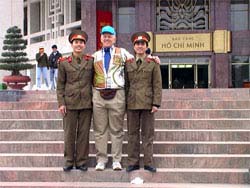
A Veteran Returns... To Hanoi!

If you can only visit one city in Vietnam, or even Southeast Asia, it should be Hanoi. To visit Hanoi is to steep yourself in history, tradition, and legend in a capital that has been inhabited continuously for a millennium. Hanoi's present architecture is mainly from the 19th and 20th centuries, and the stately French-built section of town is largely intact. Hanoi is cleaner, leafier, and quieter than other big cities in Vietnam — in a word, it's "cooler." There's cooler weather, more drizzle, less traffic, less hype; the streets seem quieter, with few large billboards. There's a cooler mentality here, too-prouder, more prudish. Hanoi is a magnet for intellectuals and artists, while Saigon seems to attract entrepreneurs and hustlers.
Hanoi street life is fascinating. In the morning, you may see tai chi practitioners, martial arts exponents, badminton players, and joggers along Hoan Kiem Lake. Bicyclists wearing berets ride past with baguettes tucked into their baskets. Strolling through the old French sector, you can find a street occupied by outdoor barbers clipping their customers in front of mirrors hung off building walls. On Trang Tien Street there's a beautician at work: a woman with a flashlight mounted on her head, cleaning a customer's ears. At street corners in the Old Quarter, men with green pith helmets chat over steaming bowls of noodles. Farther along the street, women sell fresh-cut flowers from the backs of bicycles.
The City Rises
Although the banks of the Red River have beer inhabited for thousands of years, Hanoi trace its founding to 1010-the year Emperor Le Tha 16 moved his capital from Hoa Lu to this site. H named the town Thang Long, or Soaring Drag on, after an auspicious dream about a dragon arising from the city.
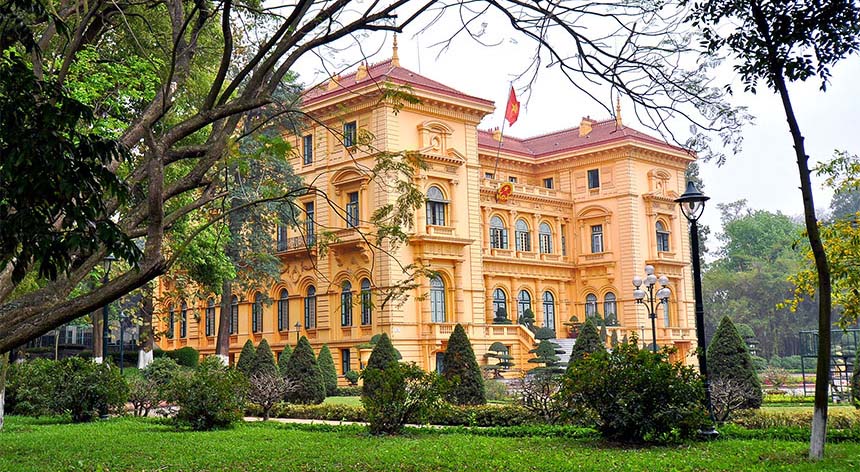
Originally, Hanoi was laid out in a patter dictated by Chinese geomancy. At its center was a walled royal city with a cosmic moon Lain; ceremonial rites and recreational function took place in this zone. The One Pillar Pagoda was constructed in 1049; the Temple of Literature, located to the south, was the first educational institution in Vietnam, established it 1070. East of the citadel and north of Float Kiem Lake was the artisan and commercial area now the Old Quarter. On the other side of the lake, east and south, was the quarter for visiting residents; later this became the French zone To the far south of the city lay a region of cemeteries, sickness, and death, where a leper colon and abattoir were relegated.
In the 12th century palaces built by Ly dynasty emperors sprouted along the Red Rive and around West Lake; the city was protected from Red River flooding by construction of massive dike. Though flooding was contained the Vietnamese could not keep out the Mongols. In the late 13th century the Mongols sacked the city, and for the next hundred-odd years th city's fortunes fluctuated. In 1428 Vietnamese leader Le Loi ousted the Chinese from the are and renamed the city Dong Kinh (Eastern Capital), later corrupted by the French to "Tonkin.”
From the 16th century on, the city fell into period of decline, culminating in the shifting the imperial court to Hue. In 1805 Emperor Gia Long, ruling from Hue, ordered the ancient citadel of Thang long destroyed, replacing with a smaller citadel constructed in the style by French military architect Sebastien de Vauban. In 1831, Emperor Duc renamed the city Hanoi, or City on the Bend of the River. This strategic bend attracted the French, who were investigating the Red River as an alternate trade route to the Mekong for shipping goods from China. In 1873 Francis Garnier was sent to reconnoiter in the area. After negotiations with the Emperor failed, Garnier attacked and destroyed the Hanoi Citadel. Upon seeing what a small French force could accomplish, Tu Duc acceded to French demands. Many old structures in Hanoi were razed to make way for new French buildings. From 1882 on, Hanoi and Haiphong were the focal points of French exploitation of the north, and Hanoi was made capital of the new protectorate of Tonkin.
In 1902, after a merger of French protectorates and colonies, Hanoi was selected as the capital of the French Indochinese Union. It was a convenient base for exploring China routes and its climate mild in comparison to Saigon's. French colonial rule came to an end in 1954 after the departure of the French and President Ho Chi Minh set about expanding Hanoi's industrial base. The city's factories were targeted by U.S. bombers from 1966 to 1972 but lucky enough central Hanoi survived the U.S. attacks as portions of the city that were hit by B-52 bombing lay mainly to the south of Hanoi. The Old Quarter and Hoan Kiem District were not bombed, although adjacent Long Bien Bridge was a constant target. Between 1965 and 1973 up to three-quarters of a the inner-city population was evacuated to rural areas.
Cessation of hostilities led to rapid migration back to the capital. Today Hanoi is one of three independent municipalities in Vietnam, covering an area of 2,139 square kilometers. The inner city is distributed in four districts and Greater Hanoi comprises 11 peripheral districts. The present population is estimated at 3.3 million.
Its true what you've heard, the historic Metropole is the only place to stay in the capital for a number of reasons. Read more about the Metropole on our web page.
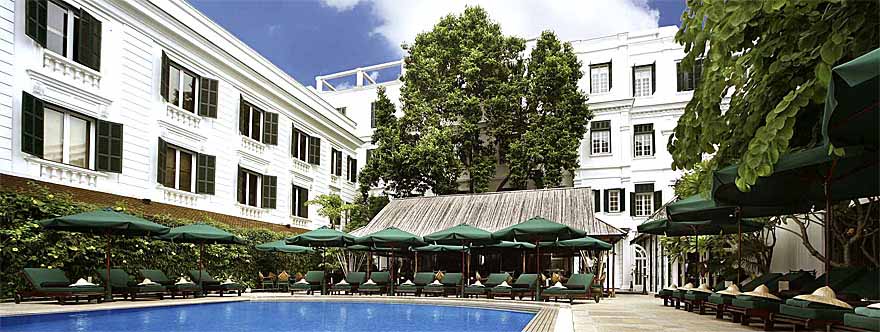
A Tale of Two Cities: Hanoi and Saigon
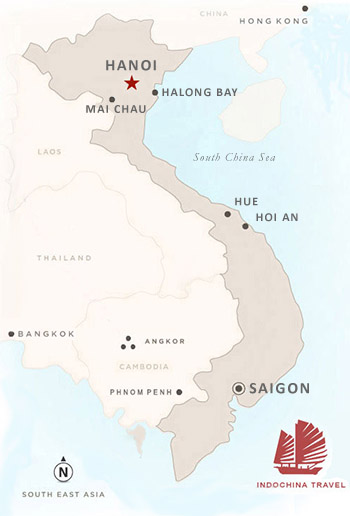 |
For centuries Hanoi was the city of primary importance in Vietnam. As the capital of French Indochina, it was a center of Vietnamese political, cultural, and economic life. During the French colonial period, Hanoi was famous for its restaurants and stylist upper class. After independence, the Hanoi region became a manufacturing center with first-rate schools and hospitals. Its several hundred thousand residents suffered many hardships in their struggle with France but still fought on to eventually unify the country. The Communists made the city the Democratic Republic of Vietnam capital in 1954, but South Vietnam's capital, Saigon, soon passed Hanoi in wealth and population size.
A major commercial center, Saigon had long dominated southern Indochina's social and commercial lifestyles. As South Vietnam's military headquarters, Saigon boomed during the American War from American financial aid and the war economy. While Hanoi's streets were busy with bicycles and handcarts, Saigon's roared with automobiles and motor scooters.
Under French rule, Saigon became a modern city with a powerful Vietnamese Roman Catholic elite-most Vietnamese were Buddhists. At the founding of the Republic of Vietnam in 1955, President Ngo Dinh Diem made Saigon the capital. The city grew rapidly as over 900,000 northern Vietnamese fled Communist North Vietnam. U.S. money flowed into the RVN government and military, enriching the city's ruling class. Saigon was notorious for government corruption, gambling dens, prostitution, and the opium trade. By 1965, the city's population was 1.5 million and growing. During your travels, observe the still very distinct personalities of the north and south. Is this another example of a north-south dichotomy found in so many other countries (Beijing/Shanghai, San Francisco/Los Angeles) in which northerners are perceived as hard-working and with a deeper sense of integrity, yet less friendlier than their southern cousins?
Hanoi at the Crossroads
Hanoi today is a city on the brink of transformation. With the opening of Vietnam to tourism and joint-venture projects, developers envision at Hanoi studded with high-rise buildings. Land of prices in Hanoi have skyrocketed to among the highest in the world. Bids are in for n 20- and 30-story office towers and apartment blocks in central Hanoi and even the conservatively-paced Hanoi People's Committee wish list includes 5,000 hotel rooms for businesspeople around West Lake. Motorcycles and mopeds are challenging bicycles as the primary mode of private transportation. Electronic goods, previously hard to come by, are now flooding in from China, arriving either legally or illegally.
Construction of high-rise office and apartment buildings and an increase in the number of hotel rooms will inevitably place more stress on road and sewage systems, power supply, and other facilities and Hanoi could become another nightmarish Asian metropolis of towering concrete monoliths and interminable traffic jams. Or, if managed properly, it could remain a low rise city with high-density population roads closed to traffic to help retain its charming character.
In 1994 the authorities evicted tenants from 150 French villas in three major streets in central Hanoi with the intention of renovating the properties and renting them at inflated prices to those willing to pay, including foreigners. An international foundation called Friends of Hanoi is raising several million dollars through sponsorship from foreign companies for a management initiative on Hanoi's architectural heritage. Friends of Hanoi has approved three projects: creation o a database containing information on buildings and infrastructure; development of internationally compatible planning and zoning laws; and public awareness program. An example of what can be done to maintain harmony is the ANZ Bank who renovated an old French villa along Hoan Kiem Lake for use a its place of business.
 A Veteran Returns... To Hanoi! |
In 1995 a scandal surfaced involving illegal construction along a one-kilometer stretch of earth embankment that protects Hanoi from Red River flooding. Hundreds of villas, mini hotels, and restaurants had appeared along the embankment, their combined weight resulting in dozens of cracks in the earth. If the embankment collapses, the flood could consume Hanoi. Trouble is, many of the new villas and buildings belong to senior party officials.
Neighborhoods
Hanoi, a city of distinct neighborhoods, is also a city of lakes. Once you sort out the lakes, it's easy to find your way around. The heart of Hanoi is the district around Hoan Kiem Lake. North of Hoan Kiem Lake is the Old Quarter, a fascinating jumble of alleys teeming with life and, unfortunately on some streets, buzzing traffic. Around the southern and eastern side of the lake is the former French zone, with cream-colored offices and green-shuttered apartment blocks and villas. Here you'll find the Opera House and former palatial residences. This is also the main commercial district, with large hotels, banks, department stores, art galleries, and shops.
In the northwest of Hanoi is Ba Dinh District, taking in the area of the former citadel. Little remains of the citadel, though the area is stills used by the military and houses the Ministry of Defense, the Army Club, and other bodies. Speaking of bodies, Ho Chi Minh's mausoleum is out this way, along with the Ho Chi Minh Museum, and high-priced villas used by Eastern European embassies. The area is leafy and green, with wide boulevards-ideal for bicycling: The Ba Dinh District also encompasses Giang Vo Lake, an area of nascent four-star hotels.
In the north end of Hanoi are True Bach Lake and West Lake (Ho lay), two exclusive residential zones. West Lake offers low-key recreational facilities and is a relaxing place to go boating.
Sights
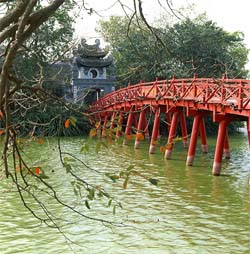 Cao The Huc (Rising Sun) Bridge |
HOAN KIEM LAKE
Hoan Kiem, or the Lake of the Restored Sword is the center of Hanoi, both in spirit and in geographical location. You can bicycle or stroll around the lake, as thousands of Hanoians do on weekends. At the crack of dawn locals assemble on the thin parkland perimeter for an hour or so of tai chi, jogging, or badminton.
Associated with the lake is an Arthurian-type legend. In the early 15th century, so the story goes, a humble fisherman named Le Loi asked the heavens for help in resisting the Ming dynasty Chinese who occupied the north. A golden turtle from the lake then brought him a magic sword that flashed like lightning. After leading at insurrection against the Chinese, Le Loi returned to the lake, and the turtle reclaimed the sword.
At the northern end of Hoan Kiem is Ngoc Son Temple, reached by the bright red Sunbeam Bridge, an arched Chinese-style wood en structure built in 1855. Before crossing the bridge you pass Penbrush and Inkslab towers built in 1864 to commemorate the learned school at Nguyen Van Sieu. Ngoc Son Temple is a mixture of temples and gift shops, and is the desired place for Vietnamese to have their pictures taken. Built in the early 19th century, it has undergone a few renovations, most recently in 1994. The temple honors several Vietnamese icons, including Van Xuong, the god of literature; Quan Vu, a martial arts exponent; physician La To; and 13th-century hero Tran Hung Dao. At the back of the shrine is the preserved body of a huge turtle found in the lake in 1968. It weighed 250 kilograms and was believed to be 400 years old-some say 500 years old, to make it old enough to serve as the turtle of legend. On an islet at the south end of the lake is a dilapidated three-tiered tower, built in honor of the valiant turtle. Turtles are occasionally still sighted in the lake. On the west bank, next to the ANZ Bank, is a small temple with a statue of Le Loi.
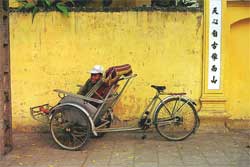 Hanoi Cyclo Driver |
There are several other pagodas in the vicinity of the lake. Popular with locals is Bada Pagoda, or Heavenly Mistress of the Stone, to the west of Hoan Kiem on Nha Tho Street. The pagoda was built in the 15th century after the discovery of a stone statue of a woman. The statue, imbued with magic powers, disappeared and was replaced with a wooden replica. The pagoda bears bonsai trees, oriental vases, and an impressive array of Buddha statuary.
WATER PUPPETRY
Without a doubt, one of the top attractions in Hanoi is water puppetry. This exuberant and magical art form is intended for children but will delight adults as well. Unique to Vietnam, it's seen regularly only in the north. The exact origins of water puppetry are uncertain, but it's known the Red River Delta area nurtured and preserved this traditional theater over many centuries. Water puppetry was a village festival art before it became a theatrical one. Temporary theaters were constructed in village ponds, and performances marked such auspicious occasions as the beginning or end of the agricultural cycle.
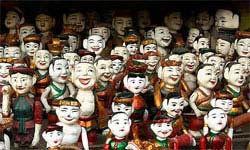 Water Puppets Theater |
For performances, a dozen puppeteers stand waist-deep in water behind a pagoda set; invisible to the audience, they manipulate puppets with a series of bamboo poles, pulleys, and strings. The pagoda pool is roughly six meters long by four meters wide. The puppets are made of lacquered wood and appear remarkably lifelike when skipping across the water. What goes on under the water is closely guarded secret some puppeteers have t swim under other puppeteers. Water plays a key part in the show-the surface is seething during naval battle, or romantically calm when a group o fairies drifts across. Underwater fireworks bright flashing dragons to life and furnish a haze of smoke for mythical settings. Puppeteers and percussionists provide explosive sound effects-rhythmic mush and zany sound effects maintain the tempo.
Coated in lacquer to make them water-resistant the wooden water puppets only last about three or four months, so new ones are constantly being produced by local artisans. The hand-carved puppets are a folk art in themselves, with larger pieces held it museum collections, and miniature copies sold a souvenirs at puppetry shows and in Hanoi shops.
Repertoire
The traditional water puppetry repertoire include up to 100 short skits. A 75-minute performance usually presents 15 to 20 short pieces, derived from fables, local legends, historic events, or adapted from popular theater. Such mythical animals as the phoenix, lion-dog, unicorn, and dragon are often shown in aquatic dances. Satirical takes at rural life are common. You may catch the story of the magic sword, a mixture of myth and history similar to the Arthurian legend of Excalibur.
OLD QUARTER
A stroll through Hanoi's happily chaotic Old Quarter will quickly lay to rest the conception that the city is gray, dull, reserved, and austere. In the anarchic jumble of the Old Quarter thrives a lively commerce in trade and handicrafts. The place is full of character - and characters. You might come across a woman trundling down a street with a shoulder pole of dual baskets bearing porcelain, or an old woman who reveals blackened teeth when she smiles, or a group of men crouched over bamboo bongs at tiny sidewalk stools. The quarter is a medieval maze of alleys lined with shops, homes, and cafes. It's best to tackle the area on foot, allowing time to stop and poke around. Unfortunately, the sidewalks are often blocked by parked motorcycles, the narrow roads filled with bicycles and motorbikes. Note: Exercise care when walking. Sidewalks can be uneven with gravel and other hazards.
The Old Quarter is known as the Quarter of the 36 Streets. The derivation of the name is not clear. East of the former citadel was the artisan and merchant quarter; in the 15th century, workshop villages clustered around this area to satisfy the royal court's need for quality products. Houses and shops stood side by side in this royal city, in a cooperative system like that of imperial Beijing or medieval Florence. Guilds worked together to transport merchandise from outlying villages, often along the Red River.
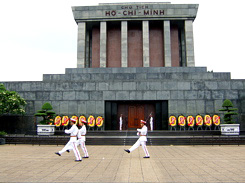 In step at the Ho Chi Minh Mausoleum |
Guild names were applied to streets - Silk Street, Paper Street, Basket Street, etc. Each guild maintained its own pagoda and patron deity; most of these "community centers" have since been turned over to other uses such as schools. Many street signs in this district begin with Pho Hang. "Pho" means "alley," "hang" means "shop" or "merchandise," and "bac" means "silversmiths," so Pho Hang Bac refers to the alley with the shops of silversmiths.
There may at one time have been 36 guild locations in the Old Quarter, but the number is more likely abstract or just plain lucky. In Asia, nine is an auspicious number; taken in the four compass directions, it multiplies to 36. In any case there are double that number of streets in the area now, and only a fraction of the activity revolves around handicrafts. Most streets are now concerned with trades - retail shops, tailors, repair shops. Trades have changed with the times you'll find entire streets given over to the sale of Russian watches, smuggled cigarettes, bootleg whiskey, motorcycle parts, shoes, pillows, Korean-made luggage, and Chinese thermos flasks Increasingly, parts of the Old Quarter are dedicated to mini-hotels and restaurants for tourists
One thing that hasn't changed much in the Old Quarter is the size of its shop houses. Shop were taxed according to the width of their marked frontage, so crafty old Hanoians built narrow shop fronts with long narrow homes behind them containing living space and storage. These red tiled three- or four-story structures are called “tube houses,” as they're only three meters wide a the front, but up to 60 meters deep. The local government is formulating plans to preserve the Old Quarter from demolition or alteration, a developers have their beady eyes on this sector, dreaming of high-rise buildings. The Old Quarter is in surprisingly good condition, with few changes to the original layout and it has been recognized by UNESCO as an important heritage site.
Let us plan your visit to the capital, a very special one, and with our local located here you will enjoy attentive service and a remarkable time.